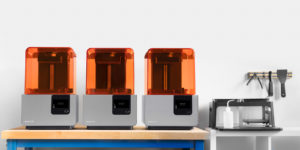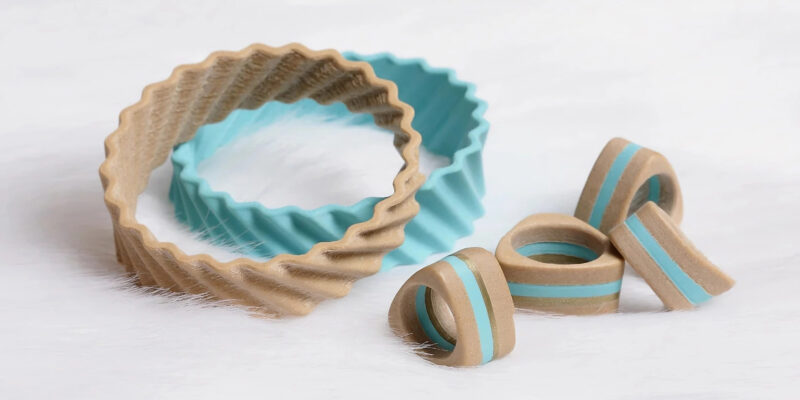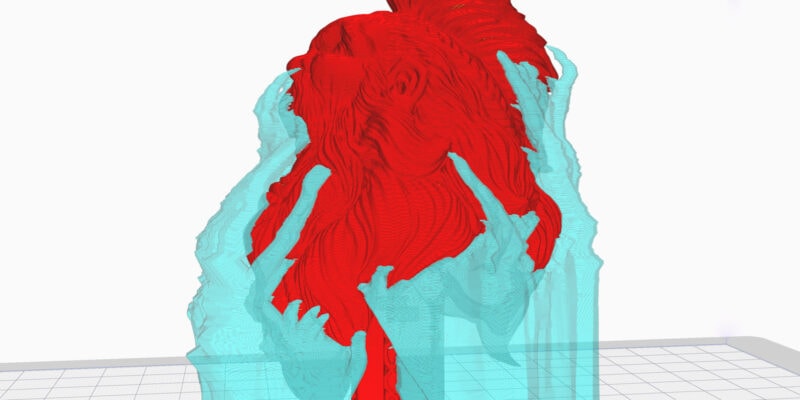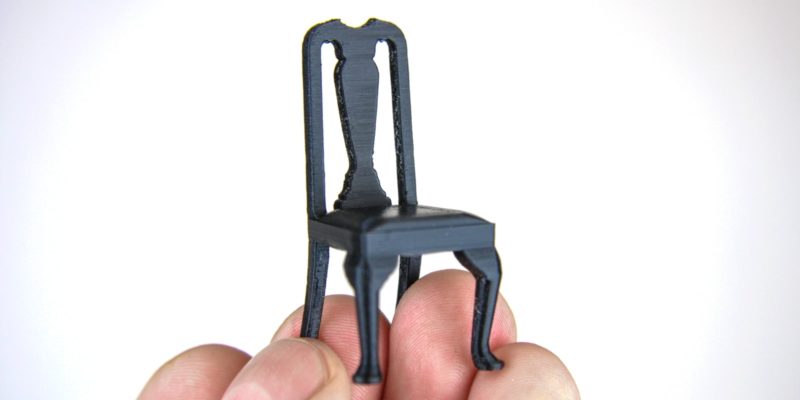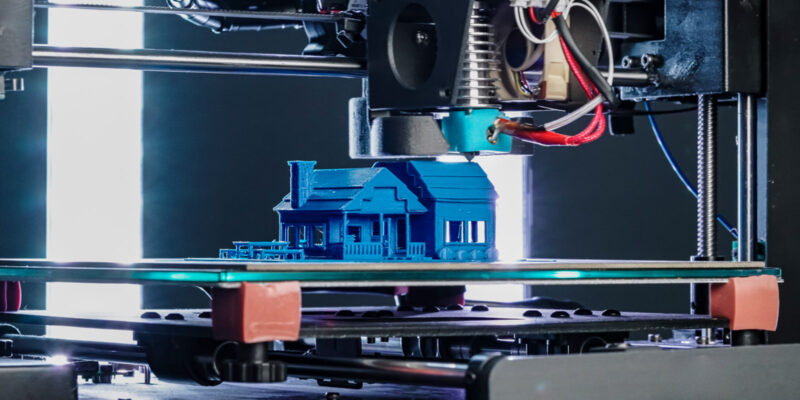SLA or stereolithography is an additive manufacturing process in which a 3D printer creates an object using photochemical processes. The 3D printer cures resin material layer by layer to create the entire 3D printed model. Parts created with stereolithography are accurate and have a smooth surface finish.
There are numerous aspects to SLA 3D printing, and it might be tough to keep all of them straight. We’ll look at stereolithography in-depth in this article, go over the history of SLA 3D printing from start to finish, as well as analyze its future prospects. By the end of the piece, you should have a good understanding of stereolithography and what you are able to do with it.
History
The origins of SLA 3D printing are as interesting as the technology itself. Originally, Hideo Kodama proposed and developed a machine that used UV light to cure polymers and create objects. This was the first invention ever in the world of 3D printing. However, he never got around to filing the patent before its deadline.
There was another failed attempt by a French group of engineers to create a successful SLA 3D printer. However, it was finally Charles Hull who perfected the rudimentary technique and submitted the first-ever patent for Stereolithography in the mid-80s. Charles later created the 3D Systems corporation, which is still a pioneer in the 3D printing world.
The first commercial stereolithographic printers were introduced to the market in 1984, and they weren’t intended for home use – these machines cost about $350,000 each.
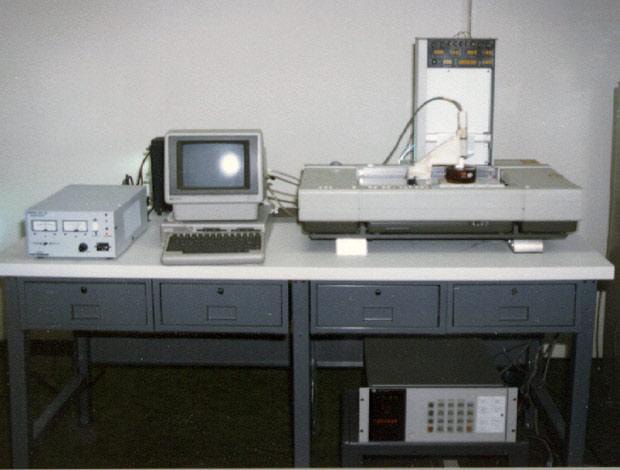
These days, you can get desktop SLA printers for a fraction of that price. The stereolithography process has become more accessible to the public over time, and that’s a good thing – it means you can get better prints for less money!
What is Stereolithography 3D Printing?
In a broader sense, stereolithography (SLA) 3D printing falls under the vat polymerization 3D printing technique. In SLA, the material used is a thermoset polymer, also known as resin. SLA materials are contained in a resin tank in the printer and are cured (polymerized) using an ultraviolet light source. With SLA 3D printing, this light source is a laser beam.
We can classify SLA 3D printers into two categories: top-down and bottom-up configuration 3D printers. The main differences lie in the size of the machines, the build area, laser arrangement, and the complexity of the entire setup. Industries mostly use top-down 3D printers, whereas desktop SLA printers typically use a bottom-up configuration.
Top-Down vs Bottom-up
In a top-down printer, the laser beam is projected down onto the surface of the resin. This type of printer is generally faster than bottom-up printers, but the prints are often less accurate.

In a bottom-up printer, the laser beam is projected up from the surface of the resin. This type of printer takes longer to print, but the prints are usually more accurate.
SLA Materials
Stereolithography 3D printers work with a material known as stereolithographic resin. This liquid resin generally has a smooth, high-stiffness finish and can create high levels of detail.
There are different types of 3D printer resin available, ranging from standard resin to engineering resins, dental resin, and clear resin. The application of the final 3D printed component plays a key role in the choice of resin.

Stereolithography (SLA) vs Digital Light Processing (DLP) 3D Printing
Stereolithography and Digital Light Processing, or DLP for short, are two popular resin-based 3D printing technologies. While they share similar characteristics, the main difference between the two lies in the light sources used for curing the resin.
The stereolithography process works by curing the liquid resin with an ultraviolet laser. DLP stereolithography instead uses a DLP projector to create stereolithography objects.

How Does an SLA Printer Work?
The workings of a stereolithography 3D printer are simple, yet complex at the same time. It’s simple in the sense that it doesn’t require a lot of moving elements and the construction of the machine itself is dense and compact. However, the SLA process itself is complex to execute and requires a lot of precision to work correctly.
We can break an SLA 3D printer down into 3 main components: a build platform, a resin tank with a transparent bottom, and a UV light source. In a desktop (bottom-up) SLA 3D printer, first, the resin is filled in the resin vat up to a marked level. The build platform is then lowered into the resin-filled vat. Then, a galvanometer arrangement guides the ultraviolet laser to cure the resin in the vat as per the model’s design.
The UV laser cures the resin spot by spot to complete a single layer. Then the build platform lifts to separate the cured resin from the transparent base, allowing an influx of fresh resin on the bottom. The 3D printer repeats this process until it completes the entire model.
After the 3D printing is done, the part is removed and washed in a bath of isopropyl alcohol to wash off any excess resin. And finally, to improve SLA parts’ mechanical properties, we can cure the component by placing it in an UV oven.
What is SLA 3D Printing Used for?
The main benefits of SLA parts are their smooth surface finish and the detail in features. So, applications that require precision-built components are the perfect candidates for SLA 3D printing.
Jewelry
The jewelry industry widely uses stereolithography 3D printing to create complex pieces of jewelry art. SLA parts provide a very high level of detail, allowing jewelry designers to create intricate designs.

For this application, you can use specially formulated castable resins that are then further used for investment castings of the jewelry.
Dental
SLA 3D printing in dental applications is mostly used to produce invisible aligners. Invisalign was the first to pioneer these kinds of aligners as opposed to the traditional metal braces.
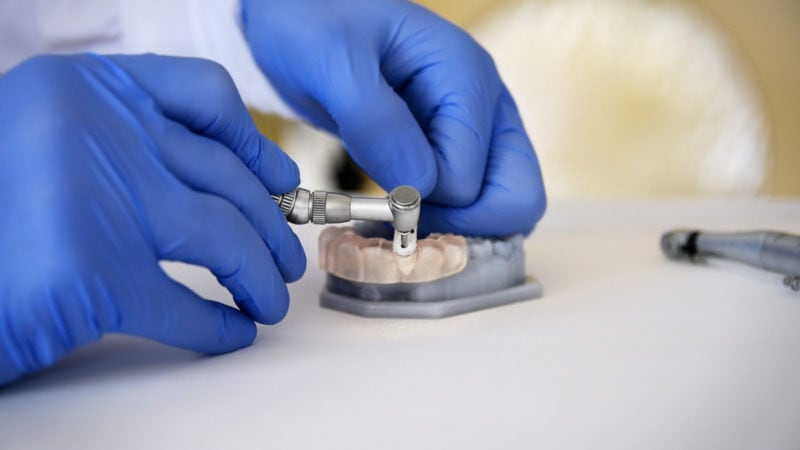
We can also use SLA 3D printed models for preparations in oral surgery. Orthodontists scan and 3D print accurate anatomical models to help in better surgery planning and simulation.
Footwear
Footwear is one of the niche and still relatively unknown applications of SLA 3D printing. Shoe industries use SLA 3D printing to design and create new kinds of shoes that provide better performance over traditional shoes.
SLA 3D printing allows you to customize each shoe, right from its applications to its material and design.
Manufacturing
SLA 3D printed parts are well suited for investment casting purposes. The ability to create tool-less patterns significantly lowers the time required for molds, allowing for faster production. It makes casting even low-volume and prototype components feasible. These significant time and tooling savings are only possible because of SLA 3D printing
Common SLA Materials
Instead of using thermoplastics, like fused deposition modeling (FDM) 3D printers do, SLA printers use photopolymers.
Thermoplastics are generally cheaper than photopolymers, and they can be used to print a wider variety of objects. However, prints made with thermoplastics are not as accurate as those made with photopolymers, and they are not as strong.
Photopolymers are more expensive than thermoplastics, but they produce more accurate and stronger prints. They are especially useful to print smaller objects more accurately.
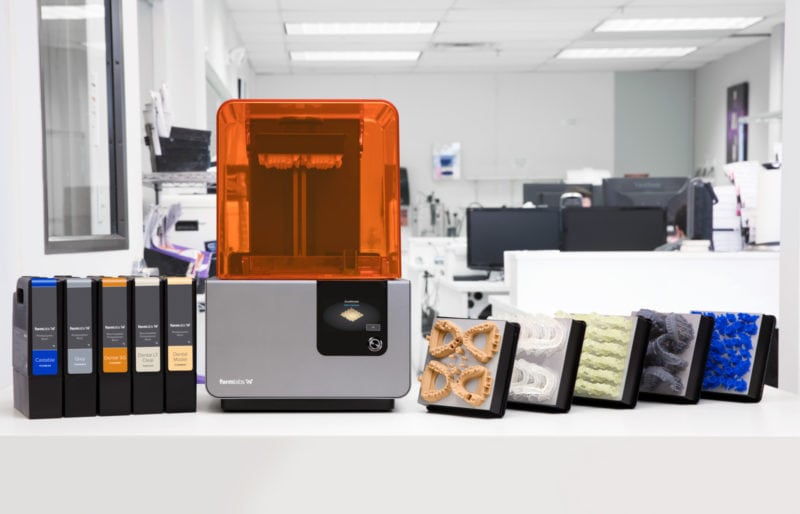
There are several types of photopolymer resins you can use for stereolithography 3D printers:
Standard Resin
While resins for stereolithography come in a lot of varieties, at different prices with different properties, a standard SLA resin is the basic and the cheapest of all. The standard resin imparts a quality surface finish, which makes it suitable for decorative pieces. It is, however, more brittle than the rest of the resins and also cannot withstand high temperatures.
Clear Resin
Clear resin is perhaps one of the unique SLA materials in the entire 3D printing materials library. With clear resin, you can create transparent parts such as clear housings for components, camera lenses, glasses, see-through models, and windows. One drawback of using this resin, however, is the amount of post-processing that’s required to get that clear finish.
Castable Resin
Castable resins are a blend of wax in powder or liquid form. They are especially useful for making molds for investment casting. The jewelry industry is particularly fond of this castable resin. By using it for casting, it keeps the finer details of the jewelry piece and decreases the amount of polishing required on the final cast metal jewelry.
Dental Resin
Dental resins are highly specialized, depending upon the particular application they’re going to be used for. You can find resins that are meant for dental models, surgical guides, aligners, denture bases, and so on. These resins need to be biocompatible and highly resistant to constant wear. The downside of these specialized resins is the high cost associated with them.
Advantages of Stereolithography
Uniform Strength
The parts produced by the SLA 3D printing process have uniform characteristics throughout the entire model. The polymerization of resin creates strong and uniform bonds within the entire material. This results in predictable mechanical properties of the component.
Unlike fused deposition modeling printed parts, the orientation of an SLA printed part does not dictate its strength.
High Precision
The curing of the liquid resin is an entirely photochemical process. It releases almost no heat, and the part does not undergo any kind of thermal expansion or contraction because of this. This results in a part that is accurate to the original design. And this accuracy is repeated layer after layer, assuring precision over the entire 3D print.
Surface Finish
The most precise SLA 3D printers can create layer heights of just 25 microns. That is 1/4th the thickness of your regular writing paper. The ultraviolet laser cures each individual point (Voxel) leading to more accurate reproduction of surface features relative to the additive manufacturing process.
The low layer thickness and reproduction of surface details give an SLA 3D printed part a smooth surface finish close to that of a part created by injection molding.
Specialty Materials
The choice for stereolithography 3D printing materials is abundant. You can get cheaper SLA resins for hobby purposes, like 3D printing miniatures, and high-end resins for specialized or industrial purposes.
Each application has its own specialized kind of resin. Dental resins, wax resins, tough resins, engineering grade resin, and other SLA materials enable SLA 3D printing to be used in all these areas.
Disadvantages of Stereolithography
Cost
The stereolithography technology comes with a higher 3D printing cost compared to fused deposition modeling. SLA resins have a high cost and a lot of it goes to waste as support structures and as leftover residue. SLA 3D printers themselves are costly as well, because of the high quality and precision of their components.
Post-Processing
SLA printed parts cannot be used right after they are printed. Instead, you are required to do significant amounts of post-processing in the SLA printing process.
You have to remove support structures, remove excess resin from the part and then cure the photosensitive polymers in the part with a UV light source like a UV curing station. This consumes extra time and resources and increases the lead time of SLA parts. This can form a hindrance when it comes to creating functional prototypes in rapid prototyping.
Expertise
Even though SLA 3D printing technology was one of the earliest 3D printing methods, it certainly is not the easiest to use. Unlike FDM 3D printers, SLA 3D printers require a certain level of training and expertise to operate them. You also need to take special care while handling raw SLA material and the final SLA parts before curing.

Material Durability
The resin material used with stereolithography is highly susceptible to ultraviolet light. Typical resin is also unsuitable for structural components due to its limited mechanical strength. Both factors limit the durability of SLA printed components, making them generally unsuitable for outdoor applications.
The Future of SLA 3D Printing
The basics of SLA 3D printing have remained the same throughout all these years. However, certain things, such as the speed of the printing process, the reliability, the choices of SLA material, and the applications of stereolithography, have improved significantly in recent years.
In the future, stereolithography could be used in almost every special-grade application. Companies such as Formlabs have brought the power of SLA to the average consumer. Chances are that you might even see an SLA 3D printer at your dentist’s clinic the next time. Likewise, various industries such as medical, prototyping and automobile are starting to realize the potential of SLA.
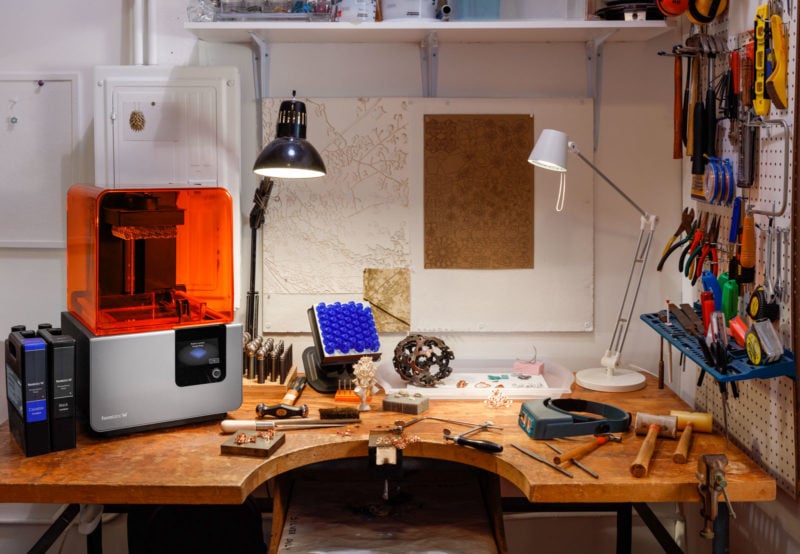
These advancements have opened up a lot of new avenues in terms of stereolithography applications. And as progress is made in the industrial applications of SLA, the process drizzle down to the SLA systems for the consumer market. This will accelerate the mass adoption of the technology, increasing the scope of SLA 3D printing even further.
Conclusion
Even though SLA was the first of the 3D printing techniques, it certainly hasn’t lost its charm. SLA is still the leading 3D printing technology in terms of its precision and specialized applications. The accuracy, smooth surface finish, speed, and material options are some of its strong points.
In terms of rapid prototyping and creating functional prototypes, fused deposition modeling is still superior. If high-detail functional prototypes are required, however, stereolithography is a great option compared to additive manufacturing and injection molding.
New innovations are being carried out daily, and companies such as Formlabs promise a bright future for SLA 3D printing. We are sure that this article might’ve cleared up a lot of your questions regarding stereolithography. Let us know your thoughts on the technology down below and feel free to ask questions that you might have.
